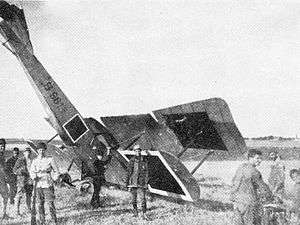Gotha LD.1
| LD.1, LD.2, LD.6, and LD.7 | |
|---|---|
 | |
| Role | Military utility aircraft |
| National origin | Germany |
| Manufacturer | Gotha |
| First flight | April 1914 |
| Primary users | Luftstreitkräfte Ottoman aviation squadrons |
The Gotha LD.1 (for Land Doppeldecker - "Land Biplane") and its derivatives were a family of military aircraft produced in Germany just before and during the early part of World War I. Used for training and reconnaissance, they were conventional designs with two-bay unstaggered wings, tailskid landing gear, and two open cockpits in tandem. Made quickly obsolete by the rapid advances in aviation technology, several were supplied as military aid to the Ottoman Empire when withdrawn from German service.
Variants
- LD.1
- Basic open-cockpit biplane
- LD.1a
- 1915 variant with a 100 hp (75 kW) Oberursel U.1 rotary engine.
- LD.2
- Similar to the LD 1a but fitted with a 100 hp (75 kW) Mercedes D.I inline piston engine.
- LD.4
- Minor changes and engine variations.
- LD.6a
- Minor changes and engine variations.
- LD.7 (B.I)
- Minor changes and fitted with a 120 hp (89 kW) Mercedes D.II inline piston engine.
Operators
Specifications (LD.1)
General characteristics
- Crew: Two, pilot and observer
- Length: 8.28 m (27 ft 2 in)
- Wingspan: 14.50 m (47 ft 6 in)
- Height: 3.45 m (11 ft 4 in)
- Wing area: 46.0 m2 (495 ft2)
- Empty weight: 590 kg (1,300 lb)
- Gross weight: 980 kg (2,160 lb)
- Powerplant: 1 × Mercedes D.I, 78 kW (105 hp)
Performance
- Maximum speed: 115 km/h (71 mph)
- Range: 520 km (320 miles)
See also
Related development
- Gotha LD.5
References
| Wikimedia Commons has media related to Gotha aircraft. |
- Taylor, Michael J. H. (1989). Jane's Encyclopedia of Aviation. London: Studio Editions. p. 428.
- Das Virtuelle Luftfahrtmuseum
This article is issued from
Wikipedia.
The text is licensed under Creative Commons - Attribution - Sharealike.
Additional terms may apply for the media files.